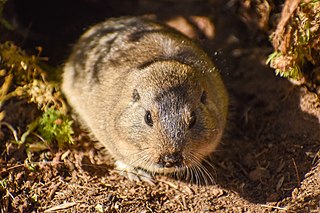
Haig's tuco-tuco, known regionally as the Patagonian tuco-tuco, is a hystricognath rodent. Like other tuco-tucos it is subterranean and thus not often observed, although the "tuc-tuc" call of the males can be heard near burrow sites, especially in the early morning. Like most species in the genus Ctenomys, C. haigi are solitary, with one adult per burrow.

The Brazilian tuco-tuco is a tuco-tuco species. It is found mainly in the state of Minas Gerais in southeastern Brazil, though Charles Darwin mentions it during his trip through present-day Uruguay.
The Argentine tuco-tuco is a species of rodent in the family Ctenomyidae. It is endemic to Argentina.

Colburn's tuco-tuco is a species of rodent in the family Ctenomyidae. Its only known habitat is in Argentina.

Emily's tuco-tuco, also called Emilio's tuco-tuco, is a species of rodent in the family Ctenomyidae. It is endemic to Argentina. This species was named after Emilio Budin, an Argentine specimen collector who worked with Oldfield Thomas.
The reddish tuco-tuco is a species of rodent in the family Ctenomyidae. Five subspecies have been recognized, some formerly designated as separate species. It is found in Argentina and Bolivia at altitudes from 600 to 4,500 m. This tuco-tuco is fossorial, like others in its genus. Its diet consists of underground tubers and roots. Its karyotype has 2n = 52 and FN = 78.
The Catamarca tuco-tuco is a species of rodent in the family Ctenomyidae. It is endemic to Argentina.

The Magellanic tuco-tuco is a species of rodent in the family Ctenomyidae. It is found in Argentina and Chile. Its natural habitat is subtropical or tropical dry lowland grassland. It is also known as the cururo by the Ona culture of Tierra del Fuego.
The San Luis tuco-tuco is a species of rodent in the family Ctenomyidae. It is endemic to Argentina.
The Salta tuco-tuco is a species of rodent in the family Ctenomyidae. It is endemic to Argentina and Bolivia.

The silky tuco-tuco is a species of rodent in the family Ctenomyidae. It is endemic to Argentina.

The Tucuman tuco-tuco is a species of rodent in the family Ctenomyidae. It is endemic to Argentina.
Budin's tuco-tuco was formerly considered a species of rodent in the family Ctenomyidae. It is endemic to southeast Jujuy Province in northwest Argentina. Given the extensive human presence in its limited range, it has been suspected to be threatened. The IUCN currently views it as a subspecies of C. frater. It was named after Emilio Budin, an Argentine specimen collector who worked with Oldfield Thomas.
The Puntilla tuco-tuco is a species of rodent in the family Ctenomyidae. It is endemic to central Argentina. The common name of the species comes from the municipality of La Puntilla at the type locality. It was first described by the British zoologist Oldfield Thomas in 1920 after being collected by Emilio Budin, an Argentine specimen collector who worked with Oldfield Thomas.
The Coyhaique tuco-tuco is a species of rodent in the family Ctenomyidae. It is endemic to southern Chile. The name comes from the Chilean province and municipality of Coyhaique.
The Famatina tuco-tuco is a species of rodent in the family Ctenomyidae. It is endemic to northern Argentina. The common name of the species comes from the municipality, department and mountain range of the same name at the type locality.
The Lago Blanco tuco-tuco is a species of rodent in the family Ctenomyidae. It is known only from the Lago Blanco area in southern Argentina. Its karyotype has 2n = 28 and FN = 42.

Flamarion's tuco-tuco or the tuco-tuco of the dunes is a rodent species of the family Ctenomyidae Its karyotype has 2n = 48 and FN = 50–78. It is endemic to the coastal dunes of Rio Grande do Sul state, southern Brazil. The species is threatened by habitat loss due to dune removal and urbanization. It is named after Brazilian biologist Luiz Flamarion B. de Oliveira.
The San Juan tuco-tuco is a species of rodent in the family Ctenomyidae. It is endemic to west central Argentina, where it is known only from southern San Juan Province.
The Jujuy tuco-tuco is a species of rodent in the family Ctenomyidae. It is known only from one location at an elevation of 500 m in southeastern Jujuy Province of northern Argentina.








